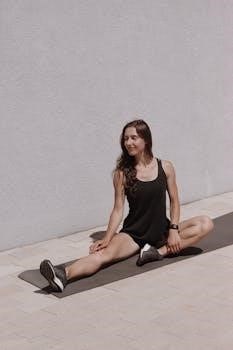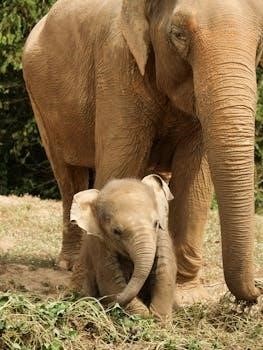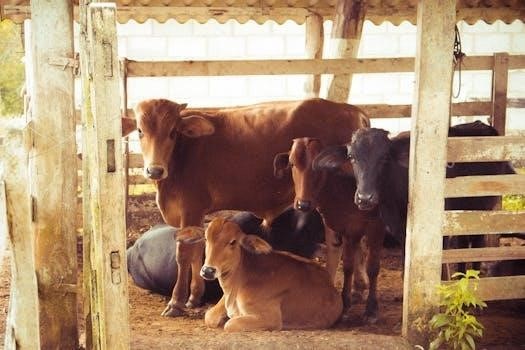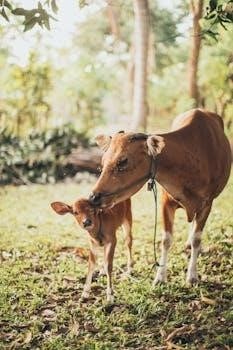Calf Stretches PDF⁚ A Comprehensive Guide
This comprehensive guide provides detailed instructions and illustrations for effective calf stretches. A downloadable PDF offers step-by-step directions. Learn to perform stretches like wall push-ups, stair stretches, and towel pulls, aiding in injury prevention and flexibility.

Calf stretches are essential for maintaining lower leg health, improving flexibility, and preventing injuries. This guide explores various calf stretches, providing detailed instructions and benefits. Calf stretches can be readily performed at home or in a gym setting, often without needing specific equipment. Addressing calf muscle tightness is crucial for athletes and individuals experiencing discomfort or limited mobility.
Whether you’re an athlete aiming to enhance performance or someone seeking relief from calf pain, this guide offers practical solutions. Stretching helps reduce muscle soreness and keeps your muscles long and flexible. Gentle calf stretches can be incorporated into your routine before or after workouts, benefiting overall lower body health. Learn how to effectively stretch your calf muscles with exercises that are easy to integrate into your daily life.
This introduction sets the stage for understanding the importance and application of various calf stretches. By following the illustrated guides and instructions, you can develop a stretching routine to maintain healthy, flexible calf muscles. These exercises will help prevent injuries, reduce pain, and improve overall lower body function.
Understanding Calf Muscles⁚ Gastrocnemius and Soleus
The calf is composed of two primary muscles⁚ the gastrocnemius and the soleus. The gastrocnemius is the larger, more superficial muscle, responsible for plantarflexion of the foot when the knee is extended. It crosses both the knee and ankle joints, making it important for activities like running and jumping. In contrast, the soleus lies underneath the gastrocnemius and only crosses the ankle joint.
Understanding the function of each muscle is crucial for effective stretching. The gastrocnemius is best stretched with the leg straight, while the soleus requires a bent knee position to isolate the stretch. Stretching both muscles helps maintain flexibility and prevents tightness, which can lead to injuries such as calf strains, Achilles tendinitis, and plantar fasciitis. Calf stretches can help treat calf strain.
Knowing how these muscles work allows for targeted stretches to address specific needs. For example, those who experience tightness primarily when walking or running might need to focus more on the gastrocnemius. Conversely, individuals with stiffness after prolonged sitting may benefit more from soleus stretches. Effectively stretching both the gastrocnemius and soleus is key to comprehensive calf muscle health.
Importance of Calf Stretching
Calf stretching is essential for maintaining lower leg health and preventing injuries. Tight calf muscles can contribute to various problems, including calf strains, Achilles tendinitis, plantar fasciitis, and even knee pain. Regular stretching improves flexibility and range of motion, which are crucial for activities like walking, running, and jumping. Incorporating calf stretches into a routine can significantly reduce the risk of these conditions.
Stretching promotes better circulation to the calf muscles, aiding in recovery after exercise and reducing muscle soreness. Flexible calf muscles also improve ankle joint mobility, leading to better balance and stability. This is particularly important for athletes and individuals who engage in high-impact activities. Moreover, calf stretching can alleviate tightness caused by prolonged sitting or standing, providing relief and comfort.
Consistent calf stretching helps maintain the appropriate length-tension relationship in the muscles, optimizing their function and reducing the likelihood of strains or tears. Whether you’re an athlete, a fitness enthusiast, or someone simply looking to improve their overall well-being, incorporating regular calf stretches into your daily routine is a proactive step towards healthier, more flexible legs. Gentle stretching reduces muscle soreness.
Standing Gastrocnemius Stretch (Straight Leg)
The standing gastrocnemius stretch, performed with a straight leg, targets the larger of the two calf muscles. To begin, stand facing a wall or sturdy object for support. Place one foot slightly behind the other, keeping the back leg straight and the heel firmly planted on the ground. Lean forward, bending your front knee while maintaining a straight back leg. You should feel a stretch in the upper part of your calf muscle.
Ensure that your toes on both feet are pointed straight ahead to maximize the effectiveness of the stretch. Hold this position for 20-30 seconds, breathing deeply to relax the muscle. Avoid bouncing or jerking movements, as this can increase the risk of injury. Repeat the stretch several times on each leg to improve flexibility. This stretch is particularly beneficial before and after activities that involve running or jumping.
Proper alignment is crucial for an effective stretch. Make sure your back knee remains locked, and your heel stays in contact with the ground throughout the exercise. If you don’t feel a stretch, try moving your back foot further away from the front foot. Regularly performing this stretch will help to improve your ankle mobility and reduce the risk of calf strains. Remember to consult with a healthcare professional if you experience any pain or discomfort during the stretch.
Standing Soleus Stretch (Bent Leg)
The standing soleus stretch, performed with a bent leg, specifically targets the soleus muscle, which lies underneath the larger gastrocnemius. Start by standing facing a wall or sturdy support. Position one foot slightly behind the other, similar to the gastrocnemius stretch, but this time, bend both your front and back knees.
Maintain your heels firmly planted on the ground. Gently lean forward, increasing the bend in your back knee until you feel a stretch in the lower part of your calf. It’s essential to keep your toes pointed straight ahead to ensure proper muscle engagement. Hold this position for approximately 20-30 seconds, breathing deeply and evenly.
Avoid any bouncing or jerky movements, which can be counterproductive and potentially lead to injury. The stretch should be felt lower in the calf compared to the gastrocnemius stretch. Repeat this exercise several times on each leg for optimal results. Regular practice of the soleus stretch can improve ankle flexibility and reduce the risk of Achilles tendon issues. If you experience any pain, adjust your positioning or consult with a physical therapist. Remember to warm up your muscles with light activity before stretching to prepare them for the exercise.
Wall Push-Up Calf Stretch
The wall push-up calf stretch is an effective method to target both the gastrocnemius and soleus muscles, contributing to overall calf flexibility and injury prevention. Begin by standing an arm’s length away from a wall, placing your hands flat against the surface at shoulder height. Position one leg slightly behind the other, ensuring that the back leg is straight for a gastrocnemius stretch.
To target the soleus, slightly bend the back knee while maintaining heel contact with the ground. Lean your body towards the wall, increasing the stretch in your calf. Focus on feeling the stretch in the targeted muscle, whether it’s the upper calf (gastrocnemius) or lower calf (soleus). Hold this position for 20-30 seconds, breathing deeply and evenly throughout the stretch.
Avoid bouncing or forcing the stretch, as this can lead to muscle strain. Repeat the exercise several times on each leg, alternating between the straight-leg and bent-leg variations to address both calf muscles comprehensively. Remember to keep your toes pointed forward to ensure proper alignment. If you experience any discomfort or pain, discontinue the stretch and consult with a healthcare professional. Incorporating this stretch regularly into your routine can improve ankle mobility and reduce the risk of calf-related injuries. Warming up prior to stretching enhances the effectiveness of the exercise.
Stair Calf Stretch
The stair calf stretch is a highly effective exercise for improving flexibility in the calf muscles, particularly targeting the gastrocnemius and soleus. To perform this stretch safely and effectively, stand on a sturdy step or raised platform, ensuring you have a secure handrail or wall for balance. Position the balls of your feet on the edge of the step, allowing your heels to hang off.
Slowly lower your heels downwards, feeling a stretch in the back of your lower legs. It’s crucial to maintain a controlled movement to avoid any sudden jerks or potential injuries. You should feel the stretch along the entire length of your calf muscles. For a deeper stretch, gently lean forward, increasing the angle of dorsiflexion at your ankles. Hold this position for 20-30 seconds, breathing deeply and evenly.
To target the soleus muscle more specifically, perform the same stretch with a slight bend in your knees. This variation places greater emphasis on the lower calf. Repeat the stretch several times on each leg, ensuring you maintain proper posture and balance throughout the exercise. Avoid overstretching or pushing yourself beyond your comfortable range of motion. If you experience any pain, discontinue the stretch immediately. Regular practice of the stair calf stretch can significantly improve ankle flexibility, reduce the risk of calf strains, and enhance overall lower body mobility.
Towel Calf Stretch
The towel calf stretch is a gentle and effective way to improve flexibility in your calf muscles, particularly useful for individuals with limited mobility or those recovering from injuries. To perform this stretch, sit on the floor with your legs extended straight out in front of you. Take a towel, or a resistance band if you have one available, and loop it around the ball of your foot.

Holding the ends of the towel with both hands, gently pull back, keeping your leg straight. You should feel a stretch along the back of your calf, from your heel to just below your knee. It is important to keep your knee as straight as comfortably possible to maximize the stretch in the gastrocnemius muscle. Hold this position for approximately 20-30 seconds, breathing deeply and evenly.
To target the soleus muscle, you can slightly bend your knee while performing the stretch. This variation will shift the focus of the stretch to the lower part of your calf. Remember to maintain a gentle, controlled pull on the towel, avoiding any sudden jerks or bounces. Repeat this stretch several times on each leg, paying attention to any areas of tightness or discomfort. The towel calf stretch is an excellent option for improving flexibility, reducing muscle soreness, and preventing calf strains, making it a valuable addition to any stretching routine.
Calf Stretches with a Board
Calf stretches using a board, or a wedge, provide an intensified stretch to the calf muscles by increasing the angle of dorsiflexion at the ankle. This method is particularly effective for targeting both the gastrocnemius and soleus muscles, contributing to improved flexibility and reduced tightness. To perform this stretch, stand on a slightly inclined board or wedge, ensuring your heels are firmly planted and your toes are pointing upwards.
Begin by standing upright, feeling the stretch in your calves. For a deeper stretch in the gastrocnemius, keep your knees straight. Lean forward slightly, increasing the stretch without lifting your heels off the board. Hold this position for 20-30 seconds, focusing on deep, even breaths. To target the soleus, slightly bend your knees while maintaining the heel contact with the board. This variation isolates the soleus muscle, providing a more specific stretch.
Repeat the stretch multiple times, alternating between the straight-knee and bent-knee variations. This will ensure both calf muscles are adequately addressed. Using a board for calf stretches can be particularly beneficial for runners, walkers, and anyone who experiences calf tightness. The increased range of motion achieved through this method can help prevent injuries and improve overall lower leg function. Always ensure the board is stable and secure to avoid any slips or falls.
Using a Foam Roller for Calf Muscles
Foam rolling is an effective self-myofascial release technique that can help alleviate tightness and improve flexibility in the calf muscles. By applying pressure to specific points, foam rolling can break up adhesions and knots, promoting better blood flow and reducing muscle soreness. To begin, sit on the floor with your legs extended in front of you. Place the foam roller under your calves, just above your ankles.
Use your hands to support your body and lift your hips off the ground, transferring your weight onto the foam roller. Slowly roll your calves over the foam roller, moving from your ankles to just below your knees. If you encounter a particularly tender spot, pause and maintain pressure on that area for 20-30 seconds, allowing the muscle to release.
Experiment with rotating your leg slightly inward and outward to target different areas of the calf muscles. For a more intense massage, cross one leg over the other to increase the pressure on the calf being rolled. Remember to breathe deeply and relax as you roll, allowing the foam roller to effectively work on the muscle tissue. Regular foam rolling of the calf muscles can help prevent injuries, improve range of motion, and enhance overall athletic performance.
Benefits and Precautions of Calf Stretching
Calf stretching offers numerous benefits, contributing significantly to overall lower body health and athletic performance. Regular calf stretches can improve flexibility, increase range of motion in the ankle joint, and reduce the risk of injuries such as calf strains, Achilles tendonitis, and plantar fasciitis. Enhanced flexibility in the calf muscles also translates to improved posture and balance, making everyday activities like walking and running more efficient.

Furthermore, calf stretches can alleviate muscle soreness after exercise, promoting faster recovery. However, it’s crucial to take certain precautions to avoid potential injuries. Before stretching, always warm up your muscles with light cardio activity, such as walking or jogging, to increase blood flow and prepare them for stretching. Avoid bouncing or jerky movements during stretches, as this can lead to muscle tears.
Hold each stretch for at least 20-30 seconds, breathing deeply and relaxing into the position. If you experience any pain, stop immediately and consult with a healthcare professional. Individuals with pre-existing conditions, such as calf strains or Achilles tendon problems, should seek guidance from a physical therapist or doctor before starting a calf stretching routine. Listen to your body and gradually increase the intensity and duration of stretches over time.
